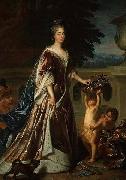
|
Francois de Troy
|
|||
|
|
|||
| French Baroque Era Painter, 1645-1730 was a French painter and engraver who became principal painter to King James II in exile at Saint-Germain-en-Laye and Director of the Academie Royale de peinture et de sculpture. One of a family of artists, Troy was born in Toulouse, the son of Nicolas de Troy (1608 - 15 September 1684), a painter in that city,and was the brother of Jean de Troy (4 April 1638 - 25 June 1691).Troy was taught the basic skills of painting by his father, and perhaps also by the more worldly Antoine Durand. François de Troy is not to be confused with his son, the portrait painter Jean-François de Troy (1679-1752), who studied under him At some time after 1662, Troy went to Paris to study portrait painting under Claude Lefebvre (1633-1675) and Nicolas-Pierre Loir (1624 - C1679]. A. P. F. Robert-Dumesnil states that this occurred when Troy was aged twenty-four. In 1669, Troy married his master Nicolas-Pierre Loir's sister-in-law, Jeanne Cotelle. In 1671, he was approved by the Academie Royale de peinture et de sculpture. In 1674, he was received into the Academy as a history painter, with a reception piece (morceau de reception) entitled Mercure coupant la tete d'Argus ('Mercury cutting off the head of Argus'). Troy's early known works include tapestry designs for Madame de Montespan, one of the many mistresses of Louis XIV of France, and paintings with religious and mythological subjects. In the 1670s, he became friendly with Roger de Piles, who introduced him to Dutch and Flemish painting, | |||
|
|
|||
|
Portrait of the duchesse du Maine new24/Francois de Troy-453455.jpg Painting ID:: 77180 |
ca. 1700 cjr | ||
|
|
|||
|
Edward Troye
|
|||
|
|
|||
| American Artist . b.1808 d.1874 American painter of Swiss birth. Before 1822, his father, Jean-Baptiste de Troy, a sculptor of minor fame, moved his family to England, where Edward was instructed in drawing and perhaps painting. The animal painter Jacques-Laurent Agasse knew the family well. Troye wrote in 1857 that he was trained in London by the best masters and stated that he followed the style of George Stubbs and John N. Sartorius. In 1831 Troye arrived in Philadelphia, where he was employed as a magazine illustrator. The following year he exhibited animal subjects at the annual Pennsylvania Academy of Fine Arts exhibition and rapidly found patrons among racehorse owners. His typical works show motionless, unsaddled and riderless animals against a low horizon | |||
|
|
|||
|
Portrait of the duchesse du Maine new24/Edward Troye-859498.jpg Painting ID:: 79607 |
ca. 1700(1700) Medium Oil cyf | ||
|
|
|||
|
Also Buy::. For Following Paintings / Artists / Products, Please Use Our Search Online: |









